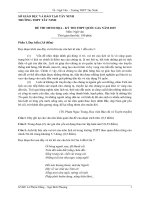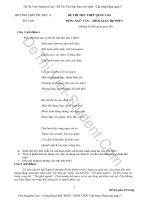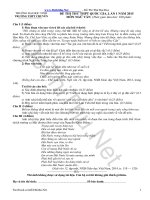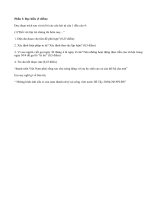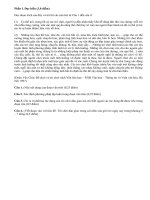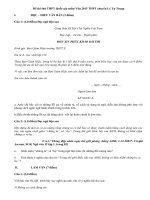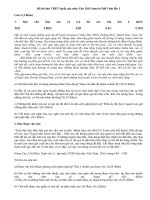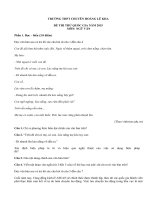ĐỀ THI THỬ THPT QUỐC GIA ANH VĂN 2018 (11)
Bạn đang xem bản rút gọn của tài liệu. Xem và tải ngay bản đầy đủ của tài liệu tại đây (633.49 KB, 5 trang )
ĐỀ LUYỆN TẬP SỐ 2
Mark the letter A, B, C, or D on your answer sheet to indicate the word whose underlined part
differs from the other three in pronunciation in each of the following questions.
Question 1.
A. leave
B. instead
C. heap
D. meat
Question 2.
A. knife
B. twice
C. hive
D. skip
Mark the letter A, B, C, or D on your answer sheet to indicate the word that differs from the
other three in the position of primary stress in each of the following questions
Question 3.
A. perform
B. reaction
C. critical
D. solution
Question 4.
A. specific
B. achievement
C. alteration
D. observe
Mark the letter A, B, C, or D on your answer sheet to indicate the underlined part that needs
correction in each of the following questions
Question 5. Whistling (A) or clapping our hands (B) to get a person’s attention are considered (C)
impolite (D)
Question 6. It is believed (A) that in the near future (B) robots will be used to doing (C) things such
as (D) cooking
Question 7. Many of the (A) important products obtained (B) from trees, one of the most (C)
important is wood pulp, which is used in paper-making (D)
Mark the letter A, B, C, or D on your answer sheet to indicate the correct answer to each of the
following questions from question 8 to question 19
Question 8.
John _________ this task yesterday morning, but I did it for him. He owes me a thankyou.
A. must have completed
C. could have completed
Question 9.
A. is
Question 10.
A. Hardly
B. should have completed
D. may have completed
It _________a long time since we were apart, I did not recognize her.
B. has been
C. was
D. had been
_________ had my teacher arrived than he gave us exercises.
B. Not until
C. When
D. No sooner
Question 11.
I really think that apologising is _________ you can do.
A. not as much as
B. a little
C. the least
Question 12.
A. Since
Question 13.
A. wherever
Question 14.
A. interest
Question 15.
A. outside
Question 16.
A. sensational
D. as far as
_________you get used to the job, it won’t seem so bad.
B. While
C. Once
D. As
Oh bother, _________ the bus I wanted to catch!
B. it’s left
C. there goes
D. owing to
From an early age, Wolfgang had a/an _______ for music.
B. passion
C. involvement
Larry never spoke to anyone, and kept himself _______.
B. withdrawn
C. superior
D. tendency
D. aloof
Sarah delivered a/an _______ appeal to the court and asked for mercy.
B. sentimental
C. emotional
D. affectionate
Page 1
Question 17.
A. and
Question 18.
A. gets on
Question 19.
Scarely had we left the house, _______ it started snowing.
B. than
C. when
D. that
What ever Jane _______ to do, she finishes.
B. sees to
C. sets out
D. looks for
The noise of the airplanes _______from the airport over my house was unbearable at
times.
A. which taking off
B. taking off
C. which was taking off
D. to take off
Mark the letter A, B, C, or D on your answer sheet to indicate the most suitable response to
complete each of the following exchanges
Question 20.
Nga: “Thanks a lot for your nice present!” Mai: “_____________”
A. Yes, it’s very nice.
B. Yes, it’s very expensive.
C. You’re welcomed.
D. I’m glad you like it.
Question 21.
"I've got two tickets for the exhibition."
"_____________"
A. Oh, let's go and get the tickets.
B. That's great. When is it?
C. Oh, anything else?
D. Thanks. I can't afford the tickets.
Mark the letter A, B, C, or D on your answer sheet to indicate the word(s) CLOSEST in meaning
to the underlined word(s) in each of the following questions
Question 22. “Please speak up a bit more, Jason. You’re hardly loud enough to be heard from the
back”, the teacher said.
A. visible
B. edible
C. eligible
D. audible
Question 23. He is an honest man. You can rely on him to do a good job.
A. take in
B. count on
C. base on
D. put up with
Mark the letter A, B, C, or D on your answer sheet to indicate the word(s) OPPOSITE in meaning
to the underlined word(s) in each of the following questions
Question 24. Mr. Brown is a very generous old man. He has given most of his wealth to a charity
organization.
A. hospitable
B. honest
C. kind
D. mean
Question 25.
A. snooty
Why are you being so arrogant?
B. humble
C. cunning
D. naive
Mark the letter A, B, C, or D on your answer sheet to indicate the sentence that is closest in
meaning to each of the following questions.
Question 26. The plan may be ingenious. It will never work in practice.
A. Ingenious as it may be, the plan will never work in practice.
B. Ingenious as may the plan, it will never work in practice.
C. The plan may be to ingenious to work in practice.
D. The plan is an impractical as it is ingenious.
Question 27. He last had his eyes tested ten months ago.
A. He had tested his eyes ten months before.
B. He had not tested his eyes for ten months then.
C. He hasn't had his eyes tested for ten months.
D. He didn't have any test on his eyes in ten months.
Question 28. The captain to his men: “Abandon the ship immediately!”
A. The captain invited his men to abandon the ship immediately.
B. The captain suggested his men abandon the ship immediately.
C. The captain ordered his men to abandon the ship immediately.
D. The captain requested his men to abandon the ship immediately.
Mark the letter A, B, C, or D on your answer sheet to indicate the sentence that best combines
each pair of sentences in the following questions.
Question 29. It was an interesting novel. I stayed up all night to finish it.
Page 2
A. I stayed up all night to finish the novel so it was interesting.
B. Unless it were an interesting novel, I would not stay up all night to finish it.
C. Though it was an interesting novel, I stayed up all night to finish it.
D. So interesting was the novel that I stayed up all night to finish it.
We arrived at the airport. We realized our passports were still at home.
A. It was until we arrived at the airport that we realize our passports were still at home.
B. We arrived at the airport and realized that our passports are still at home.
C. Not until had we arrived at the airport, we realized our passports were still at home.
D. Not until we arrived at the airport did we realize that our passports were still at home.
Q
u
e
s
t
i
o
Read the following passage and mark the letter A, B, C, or D on your answer sheet to indicate
n
the correct word or phrase that best fits each of the numbered blanks from 31 to 35.
3
Higher Education in the UK Students who have successfully completed an A-level course may go to university
0 of
to do (31)_____ three- or four-year course leading to a first degree such as Bachelor of Arts (BA), Bachelor
.
Science (BSc), etc. They apply to several universities which then (32)_____ an offer of a place specifying the
minimum grades the student needs to obtain in the A level subjects studied. Higher education is not
(33)_____. In principle, students have to pay a contribution to the cost of teaching (tuition fees) and have
also to pay their living costs (maintenance). The government provides (34)_____ to help them pay for
university education which have to be paid back from earnings once their income reaches a certain (35)_____.
Question 31. A. that
B. a
C. this
D. the
Question 32. A. create
B. do
C. make
D. get
Question 33. A. permitted
B. allowed
C. compulsory
D. free
Question 34. A. loans
B. hires
C. shares
D. rents
Question 35. A. grade
B. level
C. mark
D. rank
Read the following passage and mark the letter A, B, C, or D on your answer sheet to indicate
the correct answer to each of the questions from 36 to 42.
Every drop of water in the ocean, even in the deepest parts, responds to the forces that create the
tides. No other force that affects the sea is so strong. Compared with the tides, the waves created by the
wind are surface movements felt no more than a hundred fathoms below the surface. The currents also
seldom involve more than the upper several hundred fathoms despite their impressive sweep.
The tides are a response of the waters of the ocean to the pull of the Moon and the more distant Sun. In
theory, there is a gravitational attraction between the water and even the outermost star of the universe. In
reality, however, the pull of remote stars is so slight as to be obliterated by the control of the Moon and, to a
lesser extent, the Sun.
Just as the Moon rises later each day by fifty minutes, on the average, so, in most places, the time of
high tide is correspondingly later each day. And as the Moon waxes and wanes in its monthly cycle, so the
height of the tide varies. The tidal movements are strongest when the Moon is a sliver in the sky, and when it
is full. These are the highest flood tides and the lowest ebb tides of the lunar month and are called the spring
tides. At these times the Sun, Moon, and Earth are nearly in line and the pull of the two heavenly bodies is
added together to bring the water high on the beaches, to send its surf upward against the sea cliffs, and to
draw a high tide into the harbors. Twice each month, at the quarters of the Moon, when the Sun, Moon and
Earth lie at the apexes of a triangular configuration and the pull of the Sun and Moon are opposed, the
moderate tidal movements called neap tides occur. Then the difference between high and low water is less
than at any other time during the month.
Question 36. What is the main point of the first paragraph?
A. The waves created by ocean currents are very large.
B. Despite the strength of the wind, it only moves surface water.
C. Deep ocean water is seldom affected by forces that move water.
D. The tides are the most powerful force to affect the movement of ocean water.
Question 37. The word "felt" in line 3 is closest in meaning to
Page 3
A. based
B. dropped
C. detected
D. explored
Question 38. The words "In reality" in line 8 are closest in meaning to
A. surprisingly
B. actually
C. characteristically
D. similarly
Question 39. It can be inferred from the passage that the most important factor in determining how
much gravitational effect one object in space has on the tides is
A. size
B. distance
C. temperature
D. density
Question 40. The word "correspondingly" in line 11 is closest in meaning to
A. unpredictably
B. interestingly
C. similarly
D. unusually
Question 41. What is the cause of spring tides?
A. Seasonal changes in the weather
B. The gravitational pull of the Sun and the Moon when nearly in line with the Earth
C. The Earth's movement around the Sun
D. The triangular arrangement of the Earth, Sun, and Moon
Question 42. Neap tides occur when __________
A. the Sun counteracts the Moon's gravitational attraction
B. the Moon is full
C. the Moon is farthest from the Sun
D. waves created by the wind combine with the Moon's gravitational attraction
Read the following passage and mark the letter A, B, C, or D on your answer sheet to indicate
the correct answer to each of the questions from 43 to 50
Some animal behaviorists argue that certain animals can remember part events, anticipate future ones,
make plans and choices, and coordinate activities within a group. These scientists, however, are cautious
about the extent to which animals can be credited with conscious processing.
Explanations of animal behavior that leave out any sort of consciousness at all and ascribe actions
entirely to instinct leave many questions unanswered. One example of such unexplained behavior: Honeybees
communicate the sources of nectar to one another by doing a dance in a figure-eight pattern. The orientation
of the dance conveys the position of the food relative to the sun’s position in the sky, and the speed of the
dance tells how far the food source is from the hive. Most researchers assume that the ability to perform and
encode the dance is innate and shows no special intelligence. But in one study, when experimenters kept
changing the site of the food source, each time moving the food 25 percent father from the previous site,
foraging honeybees began to anticipate where the food source would appear next. When the researchers
arrived at the new location, they would find the bees circling the spot, waiting for their food. No one has yet
explained how bees, whose brains weigh four ten-thousandths of an ounce, could have inferred the location
of the new site.
Other behaviors that may indicate some cognition include tool use. Many animals, like the otter who
uses a stone to crack mussel shells, are capable of using objects in the natural environment as rudimentary
tools. One researcher has found that mother chimpanzees occasionally show their young how to use tools to
open hard nuts. In one study, chimpanzees compared two pairs of food wells containing chocolate chips. One
pair might contain, say, five chips and three chips, the other four chips and three chips. Allowed to choose
which pair they wanted, the chimpanzees almost always chose the one with the higher total, showing some
sort of summing ability. Other chimpanzees have learned to use numerals to label quantities of items and do
simple sums.
Question 43.
What does the passage mainly discuss?
A. Observations that suggest consciousness in animal behavior.
B. The use of food in studies of animal behavior.
C. The role of instinct in animal behavior.
D. Differences between the behavior of animals in their natural environments and in laboratory experiments.
Question 44. Which of the following is NOT discussed as an ability animals are thought to have?
A. Communicating emotions
B. Remembering past experiences
C. Selecting among choices
D. Anticipating events to come
Page 4
Question 45.
A. however
Question 46.
The word “yet” is closest in meaning to ___________.
B. generally
C. since
D. so far
What did researchers discover in the study of honeybees discussed in paragraph
2?
A. Bees are able to travel at greater speeds than scientists thought.
B. The bees were able to determine in advance where scientists would place their food.
C. Changing the location of food caused bees to decrease their dance activity.
D. The bees could travel 25% farther than scientists expected.
Question 47.
It can be inferred from the passage that brain size is assumed to
___________.
A. be an indicator of cognitive ability
B. be related to food consumption
C. correspond to levels of activity
D. vary among individuals within a species
Question 48. Why are otters and mussel shells included in the discussion in
Q
paragraph 3?
u
A. To provide that certain species demonstrate greater ability in tool use than otherA
e
.
species.
ts
t
B. To provide an example of tool use among animals.
e
c
i
C. To show that animals are very good at using objects in their habitat.
h
o
D. To provide an example of the use of weapons among animals.
n
n
i
The word “rudimentary” in meaning to ___________.
c
4
B. basic C. superior
D. original
a
9
l
Question 50. Scientists concluded from the experiment with chimpanzees and chocolate
.
chips that chimpanzees __________.
A. prefer to work in pairs or groups
B. have difficulty selecting when given choices
C. lack abilities that other primates have
D. exhibit behavior that indicates certain mathematical abilities

